Email marketing remains one of the most effective channels for businesses to connect with their audience, drive engagement, and generate revenue. However, the success of any email marketing campaign hinges on one critical metric: email deliverability rate. Understanding what constitutes a good email deliverability rate and implementing strategies to achieve it can significantly impact the effectiveness of your campaigns. In this comprehensive guide, we’ll explore the intricacies of email deliverability, share expert insights, and introduce innovative strategies, including hidden gems and advanced tools like Prism Reach, to help you optimize your email marketing efforts.
Key Deliverability Factors
Email deliverability is influenced by a multitude of factors that collectively determine whether your emails reach the intended recipients’ inboxes. Understanding these factors is essential for maintaining a high deliverability rate.
- List Quality: Maintaining a clean, permission-based email list ensures that you’re sending emails to engaged and interested recipients. Regularly removing inactive or invalid addresses can reduce bounce rates and improve deliverability.
- Authentication: Implementing authentication protocols like SPF, DKIM, and DMARC verifies your sender identity, reducing the likelihood of your emails being marked as spam.
- Sender Reputation: Your sender reputation, influenced by factors such as spam complaints and bounce rates, is crucial. A strong sender reputation signals to Internet Service Providers (ISPs) that your emails are trustworthy.
- Engagement: High engagement rates, including open and click-through rates, indicate to ISPs that your content is valuable, positively impacting deliverability.
- Content Quality: Avoiding spammy language, maintaining a balanced text-to-image ratio, and providing relevant content help prevent your emails from being flagged by spam filters.
Upgrade Your Email Marketing with AI Personalization!
How Does Email Deliverability Impact Marketing Success?
Email deliverability directly affects the reach and effectiveness of your marketing campaigns. A high deliverability rate ensures that your messages are reaching your audience, which in turn increases the chances of engagement and conversion. Here’s how deliverability impacts your marketing success:
- Increased Reach: More emails reaching inboxes mean a larger audience is exposed to your message, enhancing brand visibility and recognition.
- Higher Engagement: When emails reach the inbox, the likelihood of them being opened and interacted with increases, leading to better engagement metrics.
- Improved ROI: Higher engagement and conversion rates translate to better return on investment for your email marketing efforts.
- Enhanced Sender Reputation: Consistently high deliverability rates contribute to a strong sender reputation, making future campaigns more effective.
What is a Good Email Deliverability Rate?
Aiming for excellence in email deliverability is crucial for the success of your campaigns. In the industry, a good email deliverability rate is typically considered to be 95% or higher. This means that out of every 100 emails sent, at least 95 should successfully land in recipients’ inboxes. However, achieving and maintaining such a high deliverability rate requires a comprehensive approach addressing multiple aspects of your email marketing strategy.
Here are some benchmarks to help you gauge your deliverability performance:
- Excellent: 98-100%
- Good: 95-97%
- Average: 90-94%
- Poor: Below 90%
Keep in mind that deliverability rates can vary by industry and the nature of your email campaigns. Regular monitoring and continuous optimization are key to maintaining high deliverability rates.
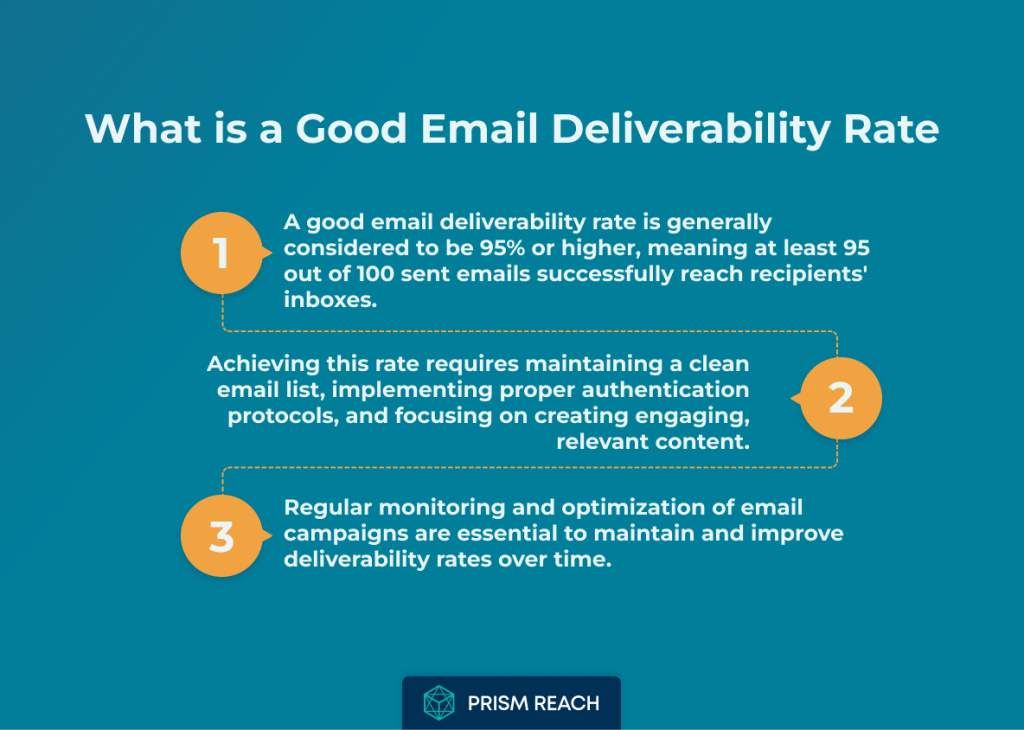
How Can I Improve My Email Deliverability Rate?
Improving your email deliverability rate requires a multi-faceted approach. Here are several strategies to help you enhance your deliverability:
- Maintain List Hygiene: Regularly clean your email list to remove inactive or invalid addresses. This reduces bounce rates and improves sender reputation.
- Implement Authentication Protocols: Ensure that your emails are authenticated using SPF, DKIM, and DMARC to verify your sender identity.
- Create Engaging Content: Focus on crafting relevant and valuable content that resonates with your audience, boosting open and click-through rates.
- Segment Your Audience: Divide your email list into smaller, targeted groups based on demographics, behavior, or preferences to create more personalized and relevant content.
- Monitor Sending Patterns: Consistent sending patterns help establish trust with ISPs. Avoid sudden spikes in email volume, which can raise red flags.
Integrating Hidden Gems for Enhanced Deliverability
Beyond the standard practices, several lesser-known but highly effective strategies can significantly boost your email deliverability rates. Here are five hidden gems to consider:
- Email Preheader Optimization: Craft compelling preheader text that complements your subject line. This often-overlooked element can significantly boost open rates and, consequently, deliverability.
- Engagement-Based Send Time Optimization: Analyze individual subscriber behavior to determine the optimal send time for each recipient, rather than using a one-size-fits-all approach.
- AI-Driven Content Scoring: Use AI tools to score your email content for potential spam triggers before sending, allowing you to make data-driven improvements.
- Behavioral Trigger Emails: Set up highly targeted automated emails based on specific user behaviors, which tend to have higher engagement rates and improve overall deliverability.
- Sender Aliases Rotation: Strategically rotate sender aliases while maintaining brand consistency to prevent fatigue and potential spam flagging from ISPs.
Implementing these hidden gems can provide a significant boost to your email deliverability rates. Tools like Prism Reach can assist in seamlessly integrating these strategies into your email marketing workflow.
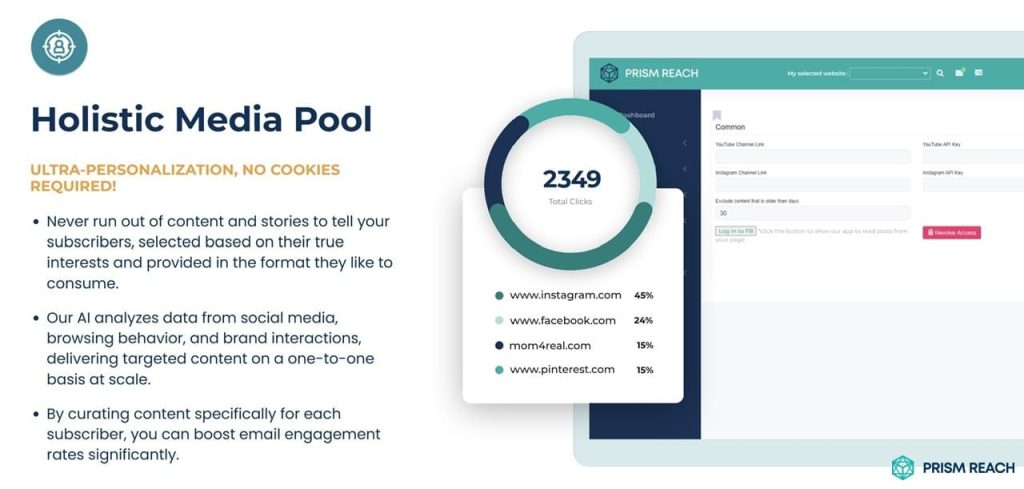
What Role Does Email Content Play in Deliverability?
The content of your emails plays a pivotal role in determining deliverability. High-quality, relevant content not only engages your audience but also signals to ISPs that your emails are valuable, thereby improving deliverability rates. Here are key aspects of email content that influence deliverability:
- Relevance: Emails that provide value and are tailored to recipients’ interests are more likely to be engaged with, positively impacting deliverability.
- Avoid Spam Triggers: Steer clear of spammy language, excessive promotional content, and maintain a balanced text-to-image ratio to prevent your emails from being flagged by spam filters.
- Personalization: Beyond using the recipient’s name, tailor your content to their preferences and behaviors. Tools like Prism Reach leverage AI to create highly personalized content, enhancing engagement and deliverability.
- Subject Lines: A compelling, non-spammy subject line can significantly impact open rates and, consequently, deliverability. A/B testing different subject lines can help identify what resonates best with your audience.
By focusing on these content strategies, you can create emails that not only reach the inbox but also engage and convert your audience effectively.
How Often Should I Monitor My Email Deliverability Rate?
Regular monitoring of your email deliverability rate is essential to maintaining and improving your email marketing performance. Here’s a recommended monitoring schedule:
- Every Campaign: Monitor deliverability metrics for each campaign sent to quickly identify and address any issues.
- Monthly Analysis: Conduct a thorough analysis of your deliverability rates monthly to spot trends and make informed adjustments to your strategy.
- Quarterly Audits: Perform in-depth audits quarterly or bi-annually to assess the overall health of your email marketing program and implement long-term improvements.
Consistent monitoring allows you to maintain a proactive approach, swiftly addressing any drops in deliverability and ensuring your email marketing remains effective. Tools like Prism Reach provide real-time analytics and alerts, making it easier to keep track of your deliverability metrics.
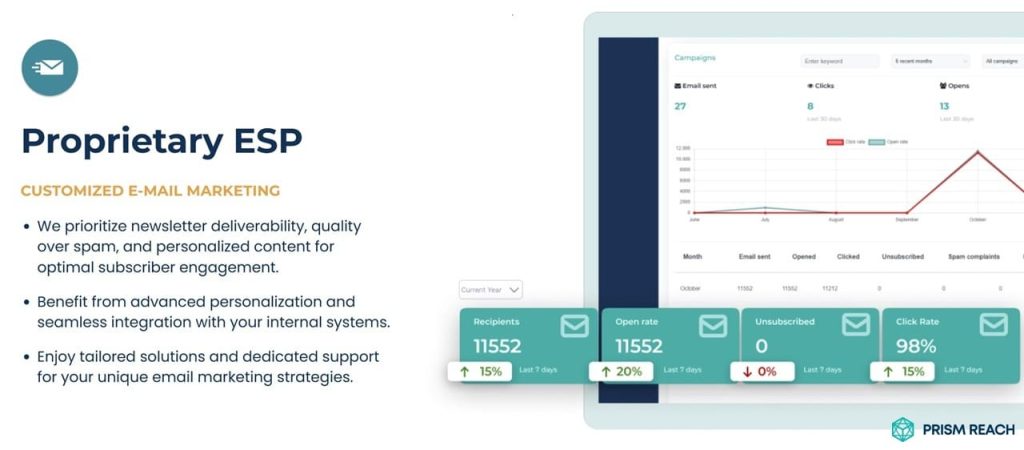
What Are Common Pitfalls That Hurt Email Deliverability?
Several common mistakes can severely impact your email deliverability rates. Avoiding these pitfalls is crucial for maintaining a strong sender reputation and ensuring your emails reach the inbox:
- Purchasing Email Lists: Buying email lists often leads to high bounce rates and spam complaints, damaging your sender reputation.
- Inconsistent Sending Patterns: Irregular sending volumes can raise red flags with ISPs, leading to lower deliverability rates.
- Ignoring Engagement Metrics: Continuing to send emails to unresponsive subscribers can harm your sender reputation and reduce overall engagement.
- Neglecting Authentication Protocols: Failing to implement SPF, DKIM, and DMARC can result in your emails being marked as spam.
- Using Shared IP Addresses: Sharing IP addresses with other senders can affect your deliverability if others on the same IP have poor sending practices.
Additionally, failing to properly warm up a new IP address can lead to deliverability issues. Gradually increasing your sending volume helps establish a positive sender reputation with ISPs. Tools like Prism Reach can automate the IP warm-up process, ensuring a smooth transition when launching new campaigns.
How Does AI Technology Enhance Email Deliverability?
Artificial Intelligence (AI) has revolutionized email marketing by providing advanced tools and insights that enhance deliverability. Here’s how AI technology can boost your email deliverability:
- Hyper-Personalization: AI-powered tools like Prism Reach analyze subscriber behavior and preferences to create highly targeted and relevant content, increasing engagement and deliverability.
- Predictive Analytics: AI can predict which subscribers are most likely to engage with certain types of content or at specific times, optimizing send times and content relevance.
- Content Scoring: AI-driven content scoring evaluates your email content for potential spam triggers, allowing you to make data-driven improvements before sending.
- Audience Segmentation: AI can automatically segment your audience based on complex engagement metrics, ensuring that each subscriber receives the most relevant content.
By leveraging AI technology, you can not only improve the relevance and engagement of your emails but also streamline your email marketing processes, resulting in better deliverability rates.
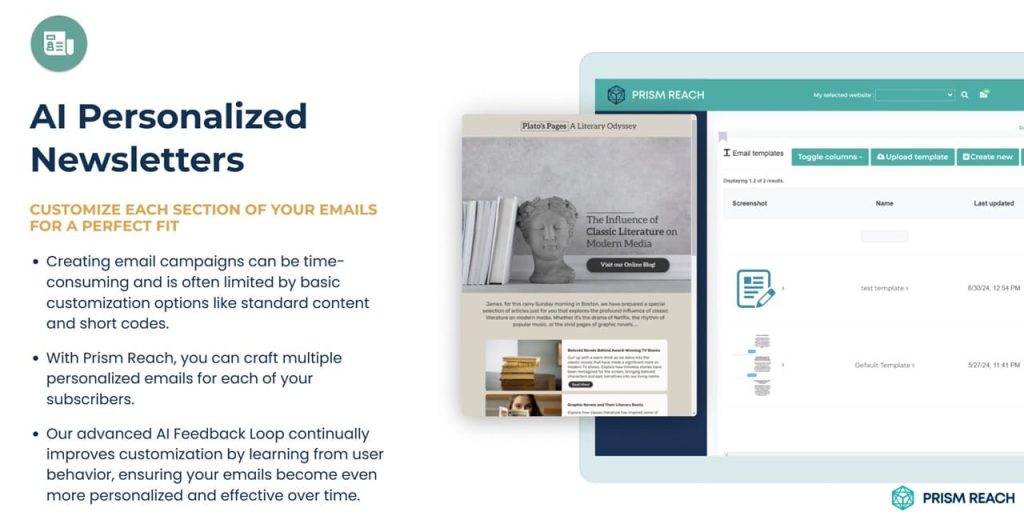
How Important Is Mobile Optimization for Email Deliverability?
In today’s mobile-first world, optimizing your emails for mobile devices is crucial for maintaining good deliverability rates. Poorly rendered emails on mobile devices can lead to negative engagement, such as deletions or spam markings, which can harm your sender reputation. Here’s why mobile optimization is essential:
- Increased Mobile Usage: A significant portion of emails are opened on mobile devices. Ensuring your emails are mobile-friendly improves the user experience and engagement rates.
- Responsive Design: Using responsive design techniques ensures that your emails adapt to different screen sizes, providing a seamless experience across devices.
- Concise Subject Lines: Mobile screens have limited space, so keeping subject lines concise (around 30-40 characters) prevents truncation and ensures your message is clear.
- Single-Column Layout: A single-column layout facilitates easy scrolling and readability on mobile devices.
- Accessible Call-to-Action Buttons: Large, easily tappable buttons enhance user interaction and drive engagement.
By implementing these mobile optimization strategies, you can significantly improve engagement rates and, consequently, your email deliverability. Tools like Prism Reach offer mobile-friendly preview options to ensure your emails render correctly across all devices.
What Role Do Feedback Loops Play in Email Deliverability?
Feedback loops are essential mechanisms provided by many ISPs that inform senders when a recipient marks their email as spam. Monitoring these feedback loops is crucial for maintaining and improving email deliverability. Here’s how feedback loops contribute to deliverability:
- Spam Complaint Alerts: Feedback loops notify you when recipients mark your emails as spam, allowing you to take immediate action.
- List Hygiene: By removing complainers from your email list, you prevent further spam complaints, protecting your sender reputation.
- Proactive Improvements: Analyzing feedback loop data helps identify patterns and issues in your email content or sending practices, enabling you to make necessary adjustments.
Implementing robust feedback loop monitoring systems can lead to dramatic improvements in deliverability rates. Prism Reach integrates feedback loop data to automatically manage and update your email lists, ensuring that spam complaints are promptly addressed.
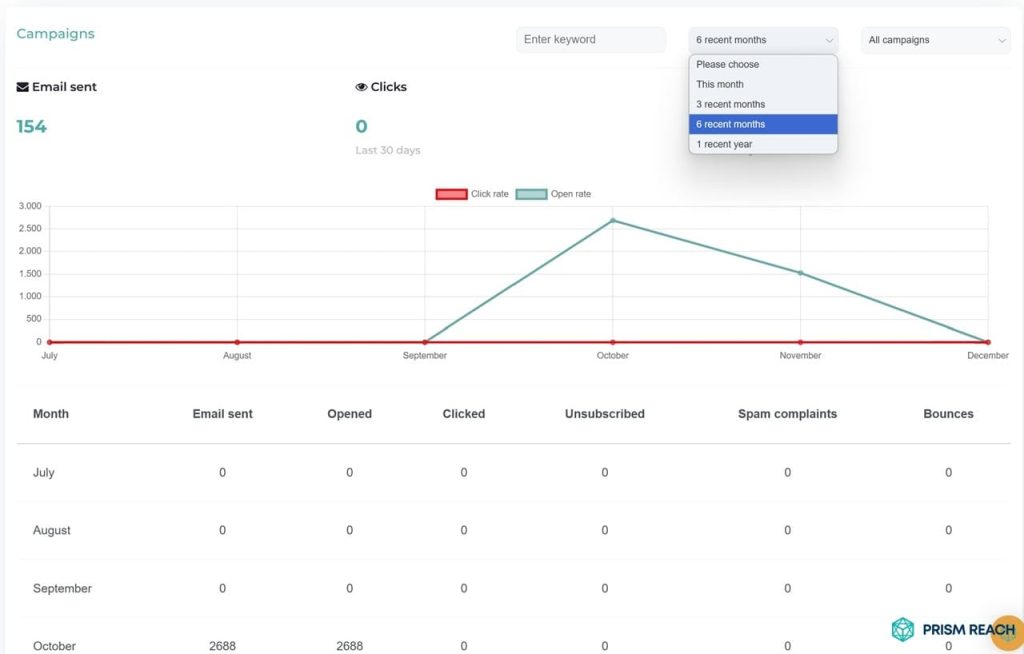
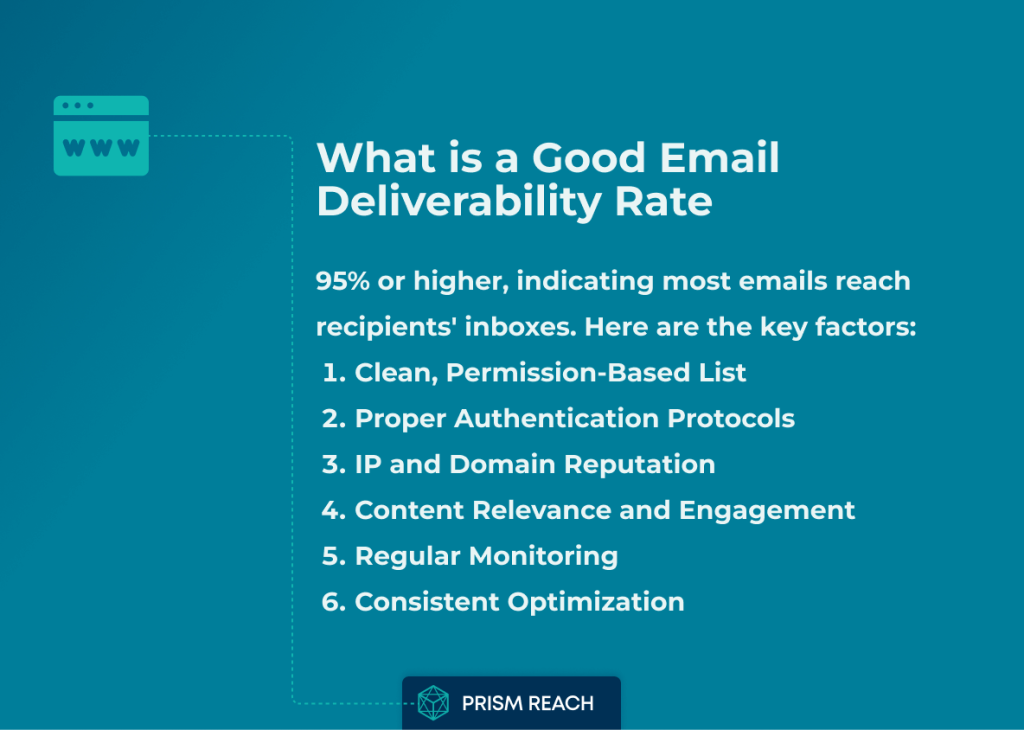
Benefits of Prism Reach for Email Deliverability
Prism Reach is an innovative AI-powered SaaS solution designed to enhance the effectiveness of email marketing campaigns through deep personalization. Here are three key benefits of using Prism Reach to improve your email deliverability:
- Increased Engagement: Publishers report up to a 40% higher engagement rate due to the personalized nature of the content delivered by Prism Reach.
- Higher Revenue: Tailored advertising and efficient content targeting lead to higher monetization rates for published newsletters.
- Improved Productivity: Automation and AI-driven insights significantly reduce the time required to create and manage campaigns, allowing marketers to focus on strategy and creativity.
By leveraging Prism Reach’s advanced AI capabilities, you can ensure that your emails are not only delivered but also resonate with your audience, driving better engagement and results.
FAQ
Conclusion
Mastering email deliverability is an ongoing journey that requires dedication, expertise, and the right tools. Throughout this article, we’ve explored the critical factors influencing deliverability, effective strategies to enhance it, and introduced advanced solutions like Prism Reach to elevate your email marketing efforts.
By focusing on list quality, authentication, engagement, and leveraging hidden gems strategies such as preheader optimization and AI-driven content scoring, you can significantly improve your deliverability rates. Regular monitoring and avoiding common pitfalls will ensure that your emails consistently reach your audience’s inboxes, driving better engagement and higher ROI.
Prism Reach stands out as a powerful tool in this endeavor, offering AI-powered personalization, seamless integration, and dynamic content selection to optimize your email campaigns. Its ability to analyze subscriber behavior and predict optimal sending times ensures that your emails are not only delivered but also resonate with your audience, fostering stronger connections and long-term success.
As the landscape of email marketing continues to evolve, staying informed about best practices and embracing innovative technologies is essential. By adopting a proactive and data-driven approach, you can navigate the complexities of email deliverability and achieve outstanding results in your email marketing efforts.
Here’s to your success in the inbox and beyond!
Sources
- Mailgun Email Industry Benchmarks
- Lead Rebel Bulk Email Deliverability Guidelines
- Wired Messenger Best Email Deliverability Tools
- Mailmodo Guide on Increasing Email Deliverability
- Omnisend Email Deliverability Blog